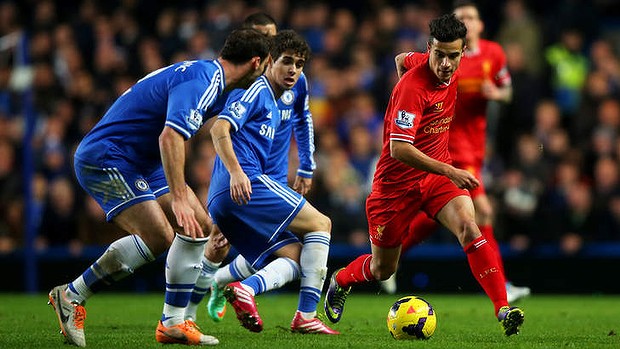The trequartista, enganche or playmaker role is best defined by his ability to fabricate and execute the impossible.
Goalscoring, assisting and creating space for team-mates have been of paramount importance for the number 10. But is this breed of player on the verge of extinction, or are they simply in the process of evolution?
The world has seen the rise of ‘inverted wingers’ (or, the return of ‘inside forwards’, whichever way you look at it) who have arguably reduced the importance of a traditional playmaker.
The panache and finesse that commanded attacks near the enemy penalty box seems to be fading away. If evolution is the way forward, then could it lead to the birth of the ‘False 10’?
This was particularly noticeable in this season’s Liverpool FC v Arsenal game at Anfield where the Reds annihilated the Gunners 5 – 1. Raheem Sterling was given the MoTM award but it was Philippe Coutinho’s performance that really caught the eye.
The little Brazilian hadn’t been at his best prior to the game but his creativity and vision is always important. Solution? Rodgers made a slight tweak to Coutinho’s role as a number 10. Rather than bursting forward and playmaking from an advanced role he was instructed to drop deeper to try and do the same.
This consequentially benefited Coutinho in a massive way. Rather than trying to create space for himself in the final third of the pitch, he dropped deep, eventually drawing the opposition players into Liverpool’s half, enabling them to play on the break.
His heat map gives a better understanding regarding his positioning throughout the game.
The Brazilian’s attacking duties weren’t the only thing that was altered. His defensive responsibilities also changed in a big way. Traditionally, attackers press high up the field trying to force an opposition error which can be exploited. Coutinho was instructed to help holding midfielder Steven Gerrard’s defensive duties in order to break up play and launch quick counter attacks.
Traditional fantasisti were never seen to have this in their repertoire but the Reds’ number 10 seemed to do a pretty decent job. Astonishingly, Coutinho made 12 tackles during the game – the highest number of tackles in the whole match. Nine of these were in Liverpool’s own half.
As soon as Liverpool stopped the opposition attack, the ball was fed to Coutinho. His sole aim was to then play penetrating, vertical passes forward as quickly as possible; one of which eventually led to a goal scored by Daniel Sturridge.
From intricate control and short passing around the box, this role seemed to be a breath of fresh air. But could Brendan Rodgers solely be credited for using this method, or do others employ the same tactic in the Premier League?
Oscar and Willian are leading examples of a modern day number 10 in the Premier League, who, alongside their flair and creativity, have incorporated a higher work rate and defensive duties to their game – thanks to manager Jose Mourinho. With Chelsea previously utilising inside forwards (Hazard/Schurrle/Mata) it caused a problem for the role of a number 10 in the team – eventually leading to Mata’s departure.
With inside forwards cutting in and running towards the box, opposition defenders usually resorted to playing narrow, allowing little or no space to the attackers, whilst also denying space where the orthodox number 10’s naturally roam.
One could argue that the playmakers real quality is seen in his ability to create space when there is none, or in simpler terms, to create order out of chaos. It’s at this point where the playmakers ability to adapt to the new demands is truly tested.
The tactical board below is a simple example of Willian’s new role. The Brazilian drops back, allowing Lampard and/or Matic to push forward to simply apply pressure on the opposition defence.
After this pressure is applied and the plan unfolds successfully, the image below gives a rough idea of Willian’s final position. This would give him those extra few seconds and that added space to distribute the ball to the best option. The opposition defenders are unable to close down Willian as it would leave Lampard/Matic in space to receive the ball.
Besides this attacking adaption, these players have had to add defensive capabilities to their game as well.
Oscar, Willian and Coutinho’s statistics provide further proof of the playmaker’s new role. The high number of tackles and interceptions is suggestive of the defensive responsibilities that these players have been burdened with.
Silva could be considered an outlier in this new trend as he’s still managed to rack up 9 assists and 7 goals in the Premier League this season. He may have contributed whilst going forward but defensively he hasn’t been as helpful. The City v Chelsea game at the Etihad being the prime example to show his drawbacks when it comes to defending. It was his positioning throughout the game that allowed Ivanovic to constantly run down the right-wing – and eventually score to give Chelsea the 1-0 win.
Mesut Ozil’s stats speak for itself. The relationship between defending and performance levels is best reflected through this. Low work rate and lethargic attitude at the times has eventually affected his goalscoring and assists tally.
Adam Lallana and Ross Barkley deserve a mention in this role. They haven’t exactly been utilised in this manner and are not the typical profile of a number 10, but their high work rate in both attack and defense could suit the criteria for a ‘false 10’ role.
Putting facts and figures aside, there remains a question as to whether these players will be able to sustain the physical demands of this role as they begin to age. It seems that the bench would become their best friend at a much earlier stage in their careers. Look at Francesco Totti; despite being 37 years old he’s still playing and influencing games for Roma in the Serie A. Would he still have the legs to play if he were made to the play like the modern playmaker in the Premier League?
The likes of Dennis Bergkamp, Roberto Baggio and Zinedine Zidane with their close control, cheeky flicks and deft passes were a rare pleasure to see, and it’s something that really puts a smile on the face of football fans around the globe. Sadly we don’t see too many of these kinds of players anymore and the ones that remain are in the process of evolution, adapting to meet the new demands of the game. Hardworking creative players are slowly beginning to replace the traditional geniuses. Is this is the only way forward for the number 10?
I certainly hope not. These players might be tactically superior, but will they really be able to create the same magic like their predecessors? Like London’s Evening Standard recently stated:
Great No.10s like Arsenal legend Dennis Bergkamp are celebrated for wizardry not work rate.









